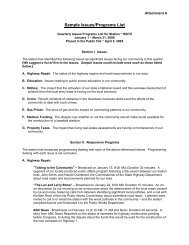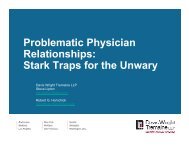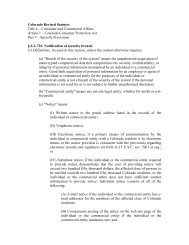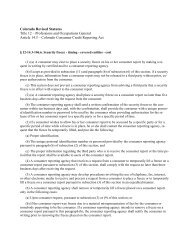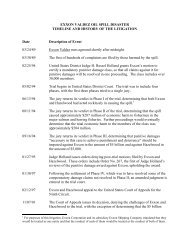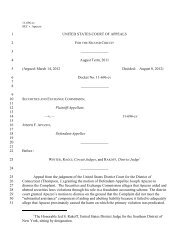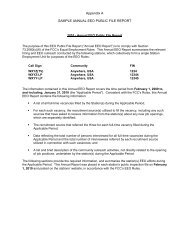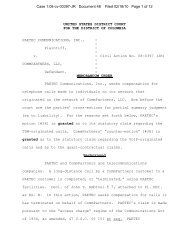QUANTA SERVICES INC, QUANTA SERVICES MANAGEMENT ...
QUANTA SERVICES INC, QUANTA SERVICES MANAGEMENT ...
QUANTA SERVICES INC, QUANTA SERVICES MANAGEMENT ...
You also want an ePaper? Increase the reach of your titles
YUMPU automatically turns print PDFs into web optimized ePapers that Google loves.
We may be required to contribute cash to meet our underfunded obligations in certain multi-employer<br />
pension plans.<br />
Our collective bargaining agreements generally require us to participate with other companies in multiemployer<br />
pension plans. To the extent those plans are underfunded, the Employee Retirement Income Security<br />
Act of 1974, as amended by the Multi-Employer Pension Plan Amendments Act of 1980, may subject us to<br />
substantial liabilities under those plans if we withdraw from them or they are terminated or experience a mass<br />
withdrawal. For example, in the fourth quarter of 2011, we recognized a $32.6 million liability when certain of<br />
our subsidiaries withdrew from an underfunded multi-employer pension plan. The amount of this liability is<br />
estimated based on information received from the multi-employer plan in 2011 and the actual amount assessed<br />
by the plan for the withdrawal, which we do not expect the plan to provide us before 2013, and the amount that<br />
we ultimately pay for the withdrawal liability may be materially different than the amount currently recorded.<br />
In addition, the Pension Protection Act of 2006 added special funding and operational rules generally<br />
applicable to plan years beginning after 2007 for multi-employer plans that are classified as “endangered,”<br />
“seriously endangered,” or “critical” status. Plans in these classifications must adopt measures to improve their<br />
funded status through a funding improvement or rehabilitation plan, which may require additional contributions<br />
from employers (which may take the form of a surcharge on benefit contributions) and/or modifications to retiree<br />
benefits. A number of multi-employer plans to which we contribute or may contribute in the future are in<br />
“endangered,” “seriously endangered” or “critical” status. The amount of additional funds we may be obligated<br />
to contribute to these plans in the future cannot be estimated, as such amounts will likely be based on future work<br />
that requires the specific use of union employees covered by these plans, and the amount of that future work and<br />
the number of employees that may be affected cannot reasonably be estimated. Should we provide in the future a<br />
significant amount of services in areas that require us to utilize unionized employees covered by these affected<br />
plans, causing us to make substantial contributions, or should a determination be made that additional plans to<br />
which any of our operating units contribute are in a classification that requires additional contributions, it could<br />
detrimentally affect our results of operations, financial condition or cash flows if we are not able to adequately<br />
mitigate these costs.<br />
Our unionized workforce and related obligations could adversely affect our operations.<br />
As of December 31, 2011, approximately 48% of our hourly employees were covered by collective<br />
bargaining agreements. Although the majority of the collective bargaining agreements prohibit strikes and work<br />
stoppages, certain of our unionized employees participated in a strike and work stoppage during January 2012,<br />
and we cannot be certain that strikes or work stoppages will not occur in the future. Strikes or work stoppages<br />
can adversely impact our relationships with our customers and could cause us to lose business and decrease our<br />
revenue.<br />
Our ability to complete future acquisitions could be adversely affected because of our union status for a<br />
variety of reasons. For instance, our union agreements may be incompatible with the union agreements of a<br />
business we want to acquire and some businesses may not want to become affiliated with a union-based<br />
company. Additionally, we may increase our exposure to withdrawal liabilities for underfunded multi-employer<br />
pension plans to which an acquired company contributes.<br />
Approximately 52% of our hourly employees are not unionized. Under the current presidential<br />
administration, certain administrative and regulatory actions have been taken and are being considered that could<br />
create more flexibility and opportunity for labor unions to organize non-union workers and could result in a<br />
greater percentage of our workforce being subject to collective bargaining agreements, heightening the risks<br />
described above. In addition, certain of our customers require or prefer a non-union workforce, and they may<br />
reduce the amount of work assigned to us if our non-union labor crews were to become unionized, which could<br />
negatively affect our business and results of operations.<br />
24




